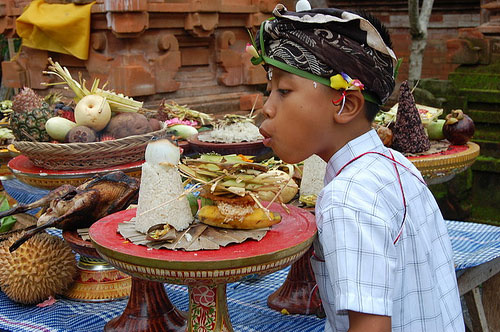Ancestors are very important to the Balinese. Each Balinese family has a Family Temple to worship God Almighty and glorify the ancestor and of course, in this family temple ancestors worship is given a great emphasis. The Family Temple is usually situated in the kaja-kangin corner – kaja being in the direction of the holy Gunung Agung, kangin being east. In low caste families this temple is called a sanggah. Higher caste families use the term merajan or pemerajan.
Although the family temple may contain shrines dedicated to manifestations of the Hindu God, Sang Hyang Widhi, the main focus is upon the deified ancestors of family. Shrines of gods are more prominent in public temples. The family temple may be small or large, but it almost always well maintained, and the family is careful to place offerings in the shrines whenever appropriate, often daily. A typical household temple usually consists of three important shrines, namely, Kemulan, Pelinggih Ratu Ngurah, and Pelinggih Taksu.
These three shrines are obligatory shrines in every family temple. The most important shrine in family temple is a roofed shrine with side-by side compartments, called a kemulan or kemulan taksu. Many people say the three section rae for Brahma, Wisnu, and Siwa – the Hindu triad. The shrine is generally on the kangin (east) side of family temple, facing the interior of the compound. Thus, as one faces the shine, Wisnu is to the left, Siwa in the middle, and Brahma to the right.
Sometimes the kemulan is described as having a center section for Bhatara Guru, an epithet for Sang Hyang Widhi, with left compartment for the female characteristics, and the right one for male. The kemulan is sometimes called the shrine of origin, and is a shrine for deified ancestors. The Pelinggih Ratu Ngurah is a shrine where Ratu Ngurah, the secretary of the Bhatara Guru, resides. Ratu Ngurah is believed to be the great watcher, who watch and take note on all human action or conduct.
This shrines is located on the kangin (east) side of the family temple, on the left side of Kemulan. It is a roofed shrine with single compartment. The pelinggih Taksu, the “place for taksu” is another obligatory shrine. The taksu is the god of one’s profession, or talent. Everyone is born with a guna (talent) of some sort, and his or her specific taksu will reside in the pelinggih taksu. The success or failure of someone in his or her profession depends on the mercy of the god who resides in this shrine.
It is also a roofed shrine, usually a single compartment and, it is located on kaja side of the family temple.





